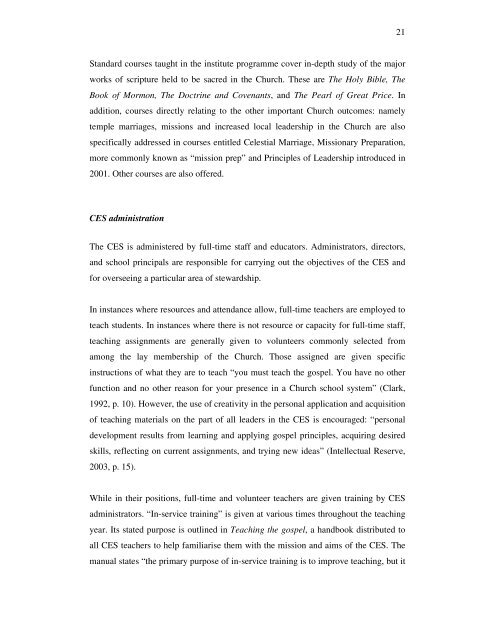nurturing servant leaders in religious education - Scholarly ...
nurturing servant leaders in religious education - Scholarly ...
nurturing servant leaders in religious education - Scholarly ...
Create successful ePaper yourself
Turn your PDF publications into a flip-book with our unique Google optimized e-Paper software.
Standard courses taught <strong>in</strong> the <strong>in</strong>stitute programme cover <strong>in</strong>-depth study of the major<br />
works of scripture held to be sacred <strong>in</strong> the Church. These are The Holy Bible, The<br />
Book of Mormon, The Doctr<strong>in</strong>e and Covenants, and The Pearl of Great Price. In<br />
addition, courses directly relat<strong>in</strong>g to the other important Church outcomes: namely<br />
temple marriages, missions and <strong>in</strong>creased local <strong>leaders</strong>hip <strong>in</strong> the Church are also<br />
specifically addressed <strong>in</strong> courses entitled Celestial Marriage, Missionary Preparation,<br />
more commonly known as “mission prep” and Pr<strong>in</strong>ciples of Leadership <strong>in</strong>troduced <strong>in</strong><br />
2001. Other courses are also offered.<br />
CES adm<strong>in</strong>istration<br />
The CES is adm<strong>in</strong>istered by full-time staff and educators. Adm<strong>in</strong>istrators, directors,<br />
and school pr<strong>in</strong>cipals are responsible for carry<strong>in</strong>g out the objectives of the CES and<br />
for oversee<strong>in</strong>g a particular area of stewardship.<br />
In <strong>in</strong>stances where resources and attendance allow, full-time teachers are employed to<br />
teach students. In <strong>in</strong>stances where there is not resource or capacity for full-time staff,<br />
teach<strong>in</strong>g assignments are generally given to volunteers commonly selected from<br />
among the lay membership of the Church. Those assigned are given specific<br />
<strong>in</strong>structions of what they are to teach “you must teach the gospel. You have no other<br />
function and no other reason for your presence <strong>in</strong> a Church school system” (Clark,<br />
1992, p. 10). However, the use of creativity <strong>in</strong> the personal application and acquisition<br />
of teach<strong>in</strong>g materials on the part of all <strong>leaders</strong> <strong>in</strong> the CES is encouraged: “personal<br />
development results from learn<strong>in</strong>g and apply<strong>in</strong>g gospel pr<strong>in</strong>ciples, acquir<strong>in</strong>g desired<br />
skills, reflect<strong>in</strong>g on current assignments, and try<strong>in</strong>g new ideas” (Intellectual Reserve,<br />
2003, p. 15).<br />
While <strong>in</strong> their positions, full-time and volunteer teachers are given tra<strong>in</strong><strong>in</strong>g by CES<br />
adm<strong>in</strong>istrators. “In-service tra<strong>in</strong><strong>in</strong>g” is given at various times throughout the teach<strong>in</strong>g<br />
year. Its stated purpose is outl<strong>in</strong>ed <strong>in</strong> Teach<strong>in</strong>g the gospel, a handbook distributed to<br />
all CES teachers to help familiarise them with the mission and aims of the CES. The<br />
manual states “the primary purpose of <strong>in</strong>-service tra<strong>in</strong><strong>in</strong>g is to improve teach<strong>in</strong>g, but it<br />
21

















